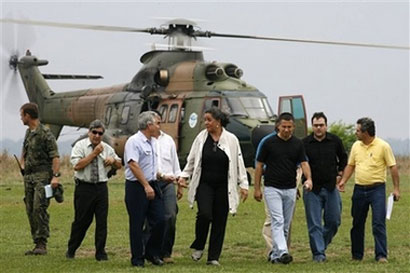Investigators on Monday were trying to determine how two new aircraft
equipped with the latest anti-collision technology clipped each other in flight,
causing a crash that killed 155 people in the nation's worst air disaster.

Family members of
victims of the Gol Boeing 737-800 plane crash, walk at the base of
operations of the Brazilian Air Force, located at the Jarina Farm, after
viewing the crash site in the northeast area of the State of Matogrosso,
Brazil, Monday, Oct. 2, 2006.
[AP]
|
Brazilian media reports, meanwhile,
suggested that a lapse in communication between air traffic controllers in
different cities may have led both planes to fly at the same altitude.
Gol airlines Flight 1907, a brand new Boeing 737-800, collided with a
Brazilian-made Legacy jet over the Amazon jungle on Friday. The damaged Legacy
landed safely at a nearby air force base, but the larger airliner crashed in
dense jungle, killing all 149 passengers and six crew members.
The Brazilian Air Force said both jets were equipped with a Traffic Collision
Avoidance System, or TCAS, which monitors other planes and sets off an alarm if
they get too close.
John Hansman, an aeronautics professor at the Massachusetts Institute of
Technology, said air traffic in Brazil is complicated in vast regions that are
not covered by radar, especially over the ocean and in the Amazon jungle.
Pilots often propose a route and at certain waypoints check in with
controllers who verify the plane's location, altitude and bearing.
"Apparently that process broke down somehow," Hansman said. "When you get to
the jungles of Brazil, you have people going in all directions."
The Boeing crashed near in the remote Amazon near Peixoto de Azevedo in the
central state of Mato Grosso, some 1,100 miles northwest of Rio de Janeiro.
The Rio de Janeiro daily O Globo reported Monday that air traffic controllers
in the city of Manaus cleared the Boeing to fly at 37,000 feet, while
controllers in Brasilia, the capital, authorized the Legacy to climb from 35,000
feet to 39,000 feet.
The Agencia Estado news agency reported that the Legacy pilot and co-pilot
told police in Mato Grosso on Sunday that they had authorization from Brasilia
to fly at 37,000 feet and that the anti-collision equipment never sounded a
warning.
As authorities struggled Monday to recover bodies scattered over the dense
jungle floor, Brazilian Air Force announced that it had recovered the voice
recorder and the digital flight data recorder from the Boeing.
Brazil's Civil Aviation Agency said the cause of the crash was impossible to
say until the recorders were examined.
Investigators will be paying close attention to the conversations between the
pilots and air traffic controllers, said Dale Oderman, associate professor of
aviation technology at Purdue University, who used to fly in Brazil.
The flight data recorder will tell investigators a great deal about the 737's
performance, including altitude and airspeed.
"It might indicate they were flying an altitude they weren't cleared to fly,"
Oderman said.
Bill Waldock, aviation safety professor at Embry-Riddle Aeronautical
University in Prescott, Ariz., speculated that the Legacy may have clipped the
bigger jet's horizontal stabilizer -fins that prevent the airplane from pitching
up or down.
"A likely reason why the 737 would depart continuous flight and go vertically
into the jungle at that speed would be damage or loss of the horizontal
stabilizer," Waldock said.
The U.S. National Transportation Safety Board said it was sending a team of
investigators, who would be joined by representatives from the Federal Aviation
Administration and Boeing Co.
The U.S. agencies were involved because the Gol plane was manufactured in the
United States and the smaller jet was registered there.
It was the first major disaster for Gol Linhas Aereas Intelligentes SA,
Brazil's second-largest airline, which took to the skies in 2001 with six Boeing
737s serving seven domestic destinations. Gol said its jet had been delivered by
Boeing Co. just three weeks ago, and had been flown for only 200 hours.